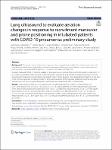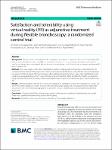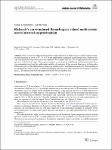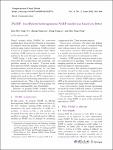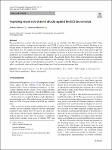Search
Author
- Osman, Ahmed I. (5)
- Daqing, Ma (3)
- Jorgensen, Ed (3)
- Li, Yan (3)
- next >
Subject
- kinh tế (26)
- Economics (12)
- programming (10)
- XRD (10)
- next >
Date issued
- 2020 - 2025 (2129)
- 2010 - 2019 (129)
- 2000 - 2009 (9)
- 1999 - 1999 (1)
Has File(s)
Search Results
This single-center preliminary prospective observational study used bedside ultrasound to assess the lung aeration modifications induced by recruitment maneuver and pronation in intubated patients with acute respiratory disease syndrome (ARDS) related to coronavirus 2019 disease (COVID-19). |
In this paper, we propose a treatment of some class of differential–difference operators in dimension one from the spectral theory point of view. These operators emerge as symmetrizations of differential operators on (0, b), 0 |
Patient comfort during invasive and therapeutic procedures is important. The use of virtual reality (VR) devices during flexible bronchoscopy (FB) as a method of distraction to increase patient tolerability and improve satisfaction has not been investigated. We aim to assess the satisfaction and tolerability of participants undergoing FB with or without VR. |
We construct and analyze a domain decomposition method to solve a class of singularly perturbed parabolic problems of reaction-diffusion type having Robin boundary conditions. The method considers three subdomains, of which two are finely meshed, and the other is coarsely meshed. The partial differential equation associated with the problem is discretized using the finite difference scheme on each subdomain, while the Robin boundary conditions associated with the problem are approximated using a special finite difference scheme to maintain the accuracy. |
Here, we present multivariate quantitative approximations of Banach space valued continuous multivariate functions on a box or RN, N∈N, by the multivariate normalized, quasi-interpolation, Kantorovich-type and quadrature-type neural network operators. We examine also the case of approximation by iterated operators of the last four types. These approximations are achieved by establishing multidimensional Jackson type inequalities involving the multivariate modulus of continuity of the engaged function or its high-order Fréchet derivatives. Our multivariate operators are defined using a multidimensional density function induced by the Richards’s curve, which is a generalized logistic function. |
The images or other third party material in this article are included in the article’s Creative Commons licence, unless indicated otherwise in a credit line to the material. If material is not included in the article’s Creative Commons licence and your intended use is not permitted by statutory regulation or exceeds the permitted use, you will need to obtain permission directly from the copyright holder. |
We investigate the application of ensemble transform approaches to Bayesian inference of logistic regression problems. Our approach relies on appropriate extensions of the popular ensemble Kalman filter and the feedback particle filter to the cross entropy loss function and is based on a well-established homotopy approach to Bayesian inference. The arising finite particle evolution equations as well as their mean-field limits are affine-invariant. Furthermore, the proposed methods can be implemented in a gradient-free manner in case of nonlinear logistic regression and the data can be randomly subsampled similar to mini-batching of stochastic gradient descent. |
We present a novel hypergraph-based framework enabling an assessment of the importance of binary classification data elements. Specifically, we apply the hypergraph model to rate data samples’ and categorical feature values’ relevance to classification labels. The proposed Hypergraph-based Importance ratings are theoretically grounded on the hypergraph cut conductance minimization concept. As a result of using hypergraph representation, which is a lossless representation from the perspective of higher-order relationships in data, our approach allows for more precise exploitation of the information on feature and sample coincidences. The solution was tested using two scenarios: undersampling for imbalanced classification data and feature selection. |
Recent publications consider side-channel attacks against the key schedule of the Data Encryption Standard (DES). These publications identify a leakage model depending on the XOR of register values in the DES key schedule. Building on this leakage model, we first revisit a discrete model which assumes that the Hamming distances between subsequent round keys leak without error. We analyze this model formally and provide theoretical explanations for observations made in previous works. Next we examine a continuous model which considers more points of interest and also takes noise into account. |
Theta sums are finite exponential sums with a quadratic form in the oscillatory phase. This paper establishes new upper bounds for theta sums in the case of smooth and box truncations. This generalises a classic 1977 result of Fiedler, Jurkat and Körner for one-variable theta sums and, in the multi-variable case, improves previous estimates obtained by Cosentino and Flaminio in 2015. Key steps in our approach are the automorphic representation of theta functions and their growth in the cusps of the underlying homogeneous space. |

